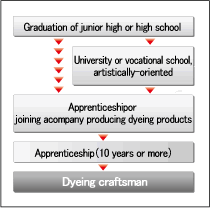 What kind of work?
What kind of work?
True-to-nature and painterly, making the best use of multi techniques for dyeing.
Craftsmen, who perform dyeing on a variety of textiles such as silk, cotton, and linen, adopting a variety of techniques including Tegaki-zome, Kata-zome, and Shibori-zome. The design may be in bold single color, true-to-nature patterns of vegetation, or geometric patterns, varies upon techniques used and the place of production. One of well-known is Yuzen-zome. Originated by Yuzenzai Miyazaki, who used to play an active role as a fan painter and established a dyeing method in Kyoto, it became spread to Kyo Yuzen, Kaga Yuzen, and Edo Yuzen. There are two different ways of dyeing process; one is consecutive that all from design making to finalizing product are done in one series, and the other is division of labor. Both of them are proven ways to realize depth of beauty of Kimono and continuing to develop while upholding the traditional techniques.
 Desired characteristics
Desired characteristics
Creating your own color. Craftsmen can learn from each other under division of labor way.
Under consequtive way, your work starts from initial conception, therefore this way of work may fit those who want to reflect the original design in Kimono. As for the way of division of labor, you will be required to be enough skilled to evaluate if the color appeared is as specified, but one of the attractive points is that you can enjoy learning from each other, from professionals such as dyeing artists and decorating craftsmen. The most important thing for you to keep in mind is “Principal is the people who puts on it”. Dyeing craftsmen are supporting players in any case. The work craftsmen must do is to finish dyeing in order to make the customer putting the Kimono look beutiful and sophisticated. On the other hand, you can expect to follow a dream to put your own name on your work, once you create an innovative design like Yuzen-zome.
 The Path to Becoming a Dyeing Craftsman
The Path to Becoming a Dyeing Craftsman
Learning at schools dedicated in dyeing.
Large proportions of craftsmen are distributed in Kansai, Hokuriku, and Kanto.
 You can learn dyeing at schools such as those offering course of Kimono dyeing craftwork, art colleges, and vocational schools. Large propotions of companies producing dyeing products, represented by Yuzen-zome for example, are distributed in Kansai, Hokuriku, and Kanto. It is said that apprenticeship for more than 10 years is required to master skilled techniques, achieve mental strength, and design sense.
You can learn dyeing at schools such as those offering course of Kimono dyeing craftwork, art colleges, and vocational schools. Large propotions of companies producing dyeing products, represented by Yuzen-zome for example, are distributed in Kansai, Hokuriku, and Kanto. It is said that apprenticeship for more than 10 years is required to master skilled techniques, achieve mental strength, and design sense.
| Products | Kimono Fabrics, Haori coat, Obi, Coat |
| Qualification | Dyeing skill |
| Related craftsmen | Tie-dye Craftsman, Drawing by hand dyeing craftsman |

